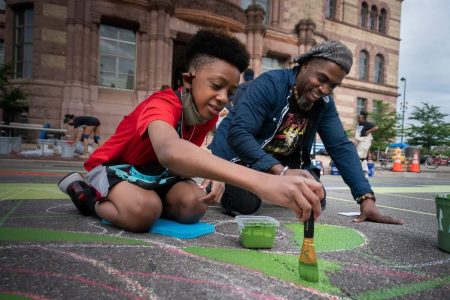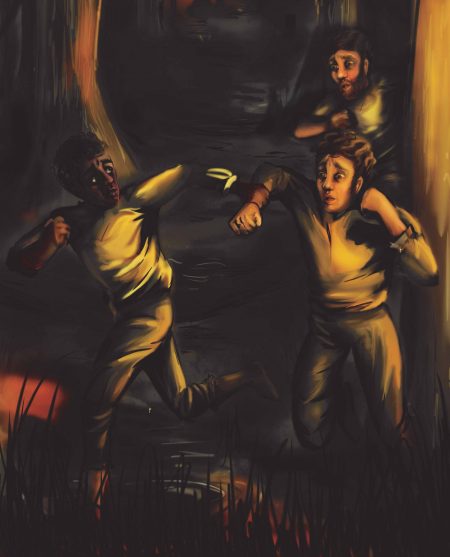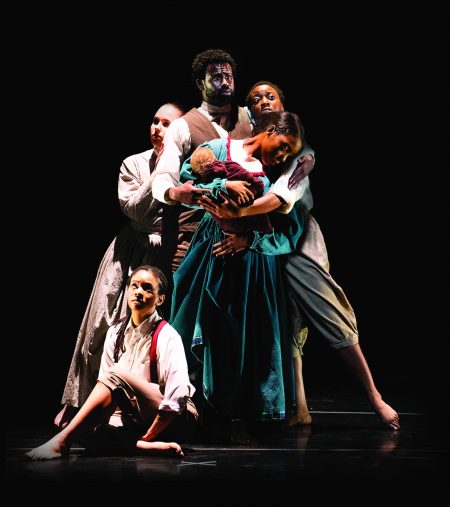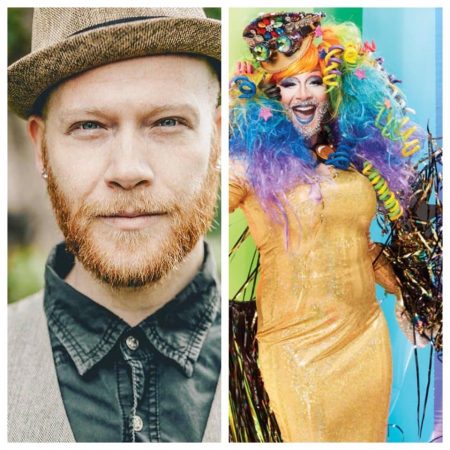Emerging Arts Leaders had a creative and Facebook conversation about The Catalyst of Black Art on October 28. Participants included Emmitt Rider, education and community engagement coordinator, Cincinnati Arts Association, panelists Asha White, Latausha Cox, Brandon Hawkins, Adoria Maxberry, Cedric Michael Cox and Vinay Duncan. They talked about their experience in creating the Black Lives Matter mural and how being involved with this significant event has impacted their art, work and life moving forward.

The Black Lives Mural spans an entire block of Plum St. in front of City Hall. Alandes Powell, board member, Urban League of Greater Cincinnati Southwestern Ohio, was the organizer behind the project. ArtsWave, ArtWorks Cincinnati and the Urban League were among the donors for the project. Artists Brandon Hawkins and Gary Horton were the project managers leading seventeen artists. The BLM human rights movement was founded in 2013.
All the participants talked about the collaboration of African American artists in creating the mural even when it rained and mentioned how they received requests for additional work. Each artist decorated a letter in Black Lives Matter with their story in art.
Cedric Michael Cox is an art educator, well known painter and President of the Board of www.aeqai.com. He said the mural reflects how things are shifting in the world.

He said as a Black artist in the city some issues have not changed. “Kennedy Heights Arts Center gave me a chance as an art educator,” he said. Cox also does outreach in the community where there are good examples of how people relate. “We need more experiences like this,” he said.
While his work crosses the boundaries of art, his African American colleagues are sometimes pigeonholed to Juneteenth, a holiday celebrating the emancipation of those who had been enslaved in the United States, and to Black History Month. “I see myself as a leader,” he said. “My work sets the tone that we are diverse,” he said. “We come in different colors, genres and subjects. I have allowed myself to be free.”
The host of the group was Rider. He said there was a poem written by Powell associated with the mural. Here is the link: https://www.artswave.org/docs/default-source/default-document-library/blmpoem.pdf?sfvrsn=4
White said, “Racism exists because of this country’s history with slavery which transitioned at its end to systemic racism and oppression. The poem this work is based on means that we want what you want. It is a plea to be seen as equals and thus treated the same as white Americans,” said White.
Maxberry, artist and owner, Most OutGROWING LLC, said, “There are so many artists making and creating things. And, they aren’t getting recognized.”
“I believe a good leader is always learning and growing. I am confident that I am currently an arts leader looking to inspire and learn from my students as well as other leaders that have come before me. Arts leadership involves education, exploration, reflection, action and much more. Having the opportunity to help people see different perspectives, challenge norms and find a voice through art is what makes my heart leap,” she said.

Hawkins asked himself, “What am I going to be in the piece?” But putting this together was gut wrenching for him. “We hit the ground. I thought I would be so nervous, but everyone hung together. Once the first day was over, we went from letter to letter. The rain hit us, but people worked together,” he said. To Hawkins, Black Lives Matter represents everything a Black artist can do. “It’s a huge project for the city,” he said. Hawkins added that future iterations of the project will take place.
This project gives each artist leverage to teach young artists in the community to strive to achieve more in the creative space.
Joan Ferrante, professor of sociology, Northern Kentucky University, and India Sada Hackle, a poet now studying at Cornell University, founded Mourning the Creation of Racial Categories project. The arts can help us explore and know what race is. This new understanding prepares us to mourn.
“I have always been a person who sees things representing something else. I am not the only one experiencing these issues,” Ferrante said. “I am very interested in social construction of reality. I see the real seriousness of what we have constructed as it pertains to race.”
The curation this year is a unique collaboration between a sociologist and poet of two racial classifications and different generations–two people who wrote and reviewed every line of this show word by word and thought hard about every image. This took months to do, and it took a month to translate the live exhibition into a virtual one. It is a collaboration that celebrates four years of thinking about race. The items chosen are drawn from the work of 125 creative, performing and visual artists from across 17 disciplines, at last count, who wrestled with how to tell the story of our nation using the lens of racial categories.
Although NKU is essentially shut down due to COVID, the current MCRC exhibit opened October 1 and will close January 31 in the Corbett Theater, designed for community art shows. On the walls are pictures depicting various themes of racism created by student artists. Some other key artists are Darnelle Pierre Benjamin, Darryl Harris and Kirsten Hurst. Ferrante would like to get a broader audience for the exhibit. There are talks on Zoom.
Ferrante is a long-time resident of Northern Kentucky with her husband Robert Wallace who teaches English at NKU. At 65, she works half time and consults with secondary schools on integrating art, reading literacy and Project Prevent that reduces violence in life. Her consulting pays for the MCRC project. She is the author of several books including “How to Respond in a Pandemic” published by Sage and co-written by 25 NKU faculty members. She felt academia needed to make a statement. “We are affected by the same things,” Ferrante said.
She noticed her students wrestling with the weight of their racial classification. “Teaching race convinced her that academic concepts alone, however compelling, were not enough to engage students in deeply meaningful ways.”
Ferrante woke up one morning in 2016 and decided to create a project of how to tell the story of race. “I wanted to do something that had relevance. She issued a “call to student artists to apply for a spot on a creative team which would explore how people in the United States came to be divided into racial categories. The goal of the project was to create art – poetry, theater, visualizations, music and dance focusing on moments when people were torn apart to live their lives in different racial categories.“ Faculty also participated.
The first year she received 40 applications and chose 16 artists. According to the website, “the art would explore partings carried out in the most sorrowful to callous ways, and every way in between. Participants read historical writings about how people were divided into racial categories and made art that focuses on the emotional experience and lasting effects of being divided. “When we recognize these effects, we can begin the work of healing,” she said. The approach encourages risk-taking, vulnerability, constructive conflict and a growth mindset.
The MCRC project, which occurs every year, begins with black and white categories because they are the most dominant of the racial divides. MCRC depends on artists shaping the message in ways that attract and engage audiences.
MCRC artistic teams created four films and are working on a fifth. They address how racial categories disregarded family, ancestors and friendships.
Ferrante wanted to teach race where the class did not fight it, but channeled emotions towards sorrow rather than defensiveness. In the call for 2021, there will be categories other than black and white.

Still from video by Kawita Vatanajyankur
Exposing the Limits opened at Wave Pool on November 14. Cal Cullen, executive director, said “The COVID19 pandemic and recent Black Lives Matter actions have illuminated a slew of inequities and injustices present in our society. There has been much discussion and press about how these occurrences have ‘exposed the limits’ of things like our healthcare system, childcare capabilities, unemployment safety nets and more. This is a group exhibition examining the inequities and stigmas associated with race, gender and class.”
Cullen said she didn’t initially think of this theme, but as a curator she wanted an exhibit that is a response to what’s happing in the world now. “These artists are responding to what’s on people’s mind,” she said.
Four diverse artists take part in this exhibit. They include Asa Featherstone IV, Prince Lang, Kawita Vatanajyankur and Xia Zhang. All of them tackle difficult subjects and the boundaries they face as artists.
Local African American artist Featherstone shows five self-portraits of microaggressions in being Black. It is a part of a series of 27 photographs that examine this theme and represent everyday encounters of racism. He creates video and still photography works that examine the human experience and bring new perspectives to many issues.
Prince Lang, a Cincinnati-based African American artist, exhibits black and white photos of household items that hold historical meaning and show how they are laced with the history of slavery. The photos are a response to Audre Lorde’s essay The Master’s Tools Will Never Dismantle the Master’s House.
Kawita Vatanajyankur, a Thai native, objectifies her body, turning it into tools for domestic labor. In one video the woman becomes a spool; in another she becomes a human shuttle for weaving. She wanted to draw attention to and question the traditional roles of women, particularly in the Asian labor force.
Xia Zhang exhibits The Flesh Mesh Shame Quilt to “collectively ruminate on deeply seated feelings of shame caused by subversive and overt repercussions of white supremacy.” Visitors write their name and examples of shame on a porcelain medallion which she bakes and puts into pockets in her quilt. At the end of the exhibit, she will send the visitor the medallion if wanted with instructions to destroy it.
The show runs until February 27 and can be seen at 2940 Colerain Ave. in Camp Washington.
Another of the ideas raised lately include LGBQT+ issues. Students at NKU talked about racial, feminist and LGBQT issues with their professors. As a result, NKU’s School of the Arts held community conversations in October and November. Entitled Summit Series, it was a virtual roundtable led by SOTA’s professors Dr. Michael Hatton and Dr. Daryl Harris, and hosted guest professionals to prompt conversation and the exchange of ideas.
The final topic on November 18 focused on Equity and Allyship: LGBTQ+ in the Arts. Panelists included Dr. Ronnie Gladden, tenured professor, whose work focuses on fostering identity, reconciliation and empowerment via authentic, transformative and diversity leadership practices for global impact. Dr. Gladden coined the term transgracial theory, which embodies the intersection of the transgender and transracial phenomena to represent the complex intersectional elements of identity, which are still evolving. His work has received notice in the Wall Street Journal.
Dan Davidson is also known as Sparkle Leigh, and appeared as a drag queen on the virtual panel. “I love talking about drag,” he said in full dress costume. He noted there are different kinds of drag queens which he plays as different characters. “Pay attention to the things you don’t want to do as well as the things you want to do. Keep an open mind,” he added. “Failure is one of the biggest gifts you can have. Work in different markets. Educate yourself on what’s out there.”
Aleksa Manila, gender queer, is a social activist and founder of Pride ASIA with a MSW. Manila, of Seattle, who is Filipino, said, “We all need support.” She focuses on marginalized congregations. “I don’t want to read Snow White and the Seven Dwarfs.” She looks at arts organizations and sees who are the executive directors and board members. There should be a response every day to people of color, not just annually.
“I want to see myself proactively engage other queer artists,” she said. She uses her drag persona as a tool for teaching and even gives speeches in drag, not just performances. Manila said, “You are all royalty. Never use your crown to look down on others. You are different than the white space.”
Trevor Browning is a student and ally, a person willing to act with and for others in pursuit of ending oppression and creating equality for LGBTQIA people. Browning talked about his experience in high school where one student came out as gay. He noted how people were treated differently. He became an ally and in college saw the bigger picture. Browning found it important to listen and understand the story of others.
Lexi Rigsby, a lesbian, talked about the importance of allyship. The discussion is continuing as people learn about each other. Rigsby noted that there are a lot of queer women in theater, so she found a place where she was comfortable.
Emily Borst who has been in theater since age 8, noticed a lack of representation of queer men and women in theater. She saw that the pioneers of the arts are white men.
Alistair Kraft is editor, American Legal Publishing, a poet and trans person. He said, “It’s a hard way to live.” After 30 years of his life, he finally came out. Kraft said his Catholic father said he wished he was dead before he came out. There was a lot of silence and awkwardness in groups, Kraft said. He felt the state of being outside. He has written books, but finds professional complications and said that it is not easy to be alone.
Moderator Harris said to the students, “You don’t have to freeze yourself at this point of your life. I’m still coming somewhere.” Hatton added, “Our bodies are political and our art and existence carries great importance. Coming out becomes an ongoing process in many ways.”
–Laura Hobson

